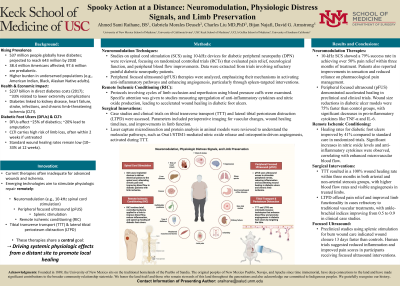Practice Innovations
(PI-036) Spooky Action at a Distance: Neuromodulation, Physiologic Distress Signals, and Limb Preservation

The rising global prevalence of chronic conditions such as obesity and type 2 diabetes demands innovative approaches to mitigate their health and economic impacts. Complications like neuropathy and chronic limb-threatening ischemia (CLTI) significantly elevate the risks of limb loss and cardiovascular events, underscoring the need for effective interventions.
Methods:
Advances in neuromodulation therapies, including 10-kHz spinal cord stimulation (SCS) for diabetic neuropathy, peripheral focused ultrasound (pFUS), and ultrasound-driven splenic stimulation, show promise in addressing diabetes-related complications and promoting wound healing. Remote ischemic conditioning (RIC) has also demonstrated efficacy in healing diabetic foot ulcers. In severe cases, surgical techniques such as tibial transverse transport (TTT) and lateral tibial periosteum distraction (LTPD) enhance blood flow, stimulate angiogenesis, and improve limb function. Combining these methods with debridement, negative pressure wound therapy, and skin grafting may further optimize outcomes.
Results:
Neuromodulation therapies appear to effectively manage complications, potentially alleviating pain and accelerating wound healing. TTT and LTPD promote angiogenesis in patients with diabetic foot ulcers and CLTI. Integrated approaches combining these surgical techniques with advanced wound care strategies improve microcirculation and support more robust healing.
Discussion:
These seemingly disparate therapies represent one unique unifying idea: creating a physiologic impact at a distance from the target. We look forward to further works in all of these areas that may confirm or refute these initially tantalizing physiologic signals.

.jpg)